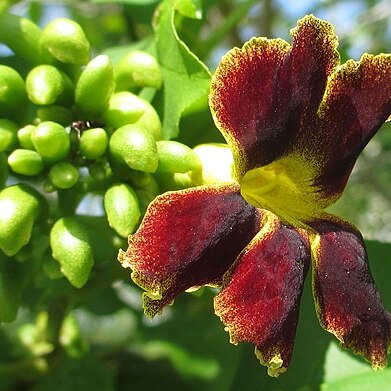Leaves up to 35 cm. long (1) 2–4-jugate, size of the leaflet-pairs increasing progressively from the base; pseudostipules 0.5–1.7(2) cm. in diam., subcircular to reniform; petiole 2–7(9) cm. long, flat above, sometimes slightly winged, terete below, leaflet lamina 2–24.5(32.5) × 2–13 cm., elliptic, obovate or almost subcircular, sessile or with petiolules up to 5 mm. long, acute, acuminate to longly acuminate, rarely obtuse at the apex, tapering towards the often asymmetric base, pubescent and minutely scaly at both surfaces, with age becoming minutely and sparsely puberulous or even glabrous; lower surface with pubescent axillary domatiae more or less conspicuous and sometimes with small circular black glands near and on both sides of the midrib; lateral nerves 6–12(14), impressed above and prominent below; margins entire or finely toothed.
A small upright tree. It grows 3-7 m tall. The crown is sparse. The bark is grey and smooth but it flakes. The leaves are light green. The leaves are compound. They have leaflets along the stalk and one at the end. There are 2 or 3 pairs of leaflets. The leaflets are broadly oval. The leaves are 14 cm long by 6 cm wide. The flowers are deep red and yellow. They are red inside and yellow with red spots outside. They occur in branched groups. They are 5 cm long by 5 cm wide. The petals are crumpled. The fruit are slender pod-like capsules. They are 30-80 cm long and split along their length. They have golden hairs. The seeds have thin wings at both ends.
Inflorescence a terminal or axillary panicle or raceme rather lax, 5–20(23) cm. long, scaly glabrous or puberulous; pedicels up to 1.5(2) cm. long, 2-bracteate below the middle; bracts 2–5(7) mm. long, triangular-acuminate, ciliate at the margins.
Small tree or shrub, 2-5 m or up to 9 m high. Pseudo-stipules foliaceous, subcircular to reniform. Calyx 10-15 mm long; corolla tube 20-30 mm long. Capsule hairless, lenticellate, sparsely lepidote. Flowers yellow-greenish flecked with maroon.
Stamen-filaments 9–14 mm. long adnate to the corolla tube up to c. 5 mm. from the base, corolla tube provided with pluricellular hairs at the insertion points of the filaments; anther-thecae c. 1.5 mm. long, divergent.
Corolla funnel-shaped to campanulate, tube (18) 20–30(43) mm. long, yellow-greenish flecked with maroon; lobes 10–15 mm. in diam., subcircular, sometimes with conspicuous small glands near the mouth.
Calyx 10–15(19) mm. long cuspidate or uncinate splitting at one side down to 8 mm. from the base sometimes provided with scattered glands towards the apex and opposite to the fissure.
Capsule slender, 22–68 × 0.9–1.5 cm., straight or slightly falcate, glabrous, lenticellate.
Young branchlets minutely lepidote, sometimes with conspicuous lenticels.
Shrub 2–5 m. tall or a small often straggling tree up to 9 m. tall.
Ovary 3–5 mm. long, sometimes lepidote; style 15–27 mm. long.
Bark grey, smooth or rough, peeling off soon.
Seeds 4–6 × 20–40 mm. including the wing.
Disk 1.5 mm. long and 2–3 mm. in diam.


